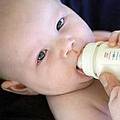 加拿大14日改選新出爐的總理哈珀(Stephen Harper),近期將立法嚴禁進口販售與宣傳含雙酚A(BPA)的塑膠奶瓶,成為全球第一個為此草擬法案的國家。
加拿大14日改選新出爐的總理哈珀(Stephen Harper),近期將立法嚴禁進口販售與宣傳含雙酚A(BPA)的塑膠奶瓶,成為全球第一個為此草擬法案的國家。
同時,加國政府亦將採取行動,限制排放到環境中的雙酚A量。加國環境部科學家發現,雙酚A滲入環境的管道包括:廢水、洗滌水與垃圾掩埋滲出水。
環境部長貝爾德(John Baird)表示「許多西尼頻(West-Nepean)區內的選民,特別是嬰幼兒的母親,都對嬰兒奶瓶內的雙酚A感到憂心忡忡。為了所有加拿大人的健康與環境,今天為嬰兒奶瓶內嚴禁雙酚A所做的宣示,證實我們做對了事。」
雙酚A是一種工業化學品,用來製造堅固、透明的塑料品如聚碳酸樹酯,簡稱PC。PC材質指用途廣泛,舉凡可重複使用的水壺與奶瓶都會用道。此外為保護食品罐頭與飲料罐內層所添加的環氧樹脂,也可見到雙酚A蹤跡。
環保團體自然資源保護協會(Natural Resources Defense Council)21日也於美國華府向聯邦食品和藥物管理局陳情,希望美國政府禁止在包裝或添加物方面使用雙酚A。
另外,加國政府建議,假使有家長或褓姆仍要使用PC奶瓶,請勿將太燙或燒滾的水倒進瓶裡,因為熱水比冷水更易引發雙酚A的釋出。衛生官員警告,應該現在非PC材質的容器內讓沸騰的水降溫後,再倒進奶瓶裡。
辨識PC瓶的方法是看一看瓶子底下的中間回收標誌上有無數字7,但有7還不夠,7的旁邊還必須有PC的記號才能確定是。假如瓶子沒有註明任何回收標誌,目前則沒有特定方式可以知道瓶子是否由PC材質所製造。
The Government of Canada led by Conservative Prime Minister Stephen Harper newly re-elected last week, will immediately draft the world's first regulations to prohibit the importation, sale and advertising of plastic baby bottles that contain the chemical bisphenol A.
The government also will take action to limit the amount of bisphenol A that is being released into the environment. Environment Canada scientists have found that bisphenol A is entering the environment through wastewater, washing residues and leachate from landfills.
"Many Canadians, especially mothers of babies and small children in my own constituency of Ottawa West-Nepean, have expressed their concern to me about the risks of bisphenol A in baby bottles," said Environment Minister John Baird. "Today's confirmation of our ban on BPA in baby bottles proves that our government did the right thing in taking action to protect the health and environment for all Canadians."
Bisphenol A is an industrial chemical used to make a hard, clear plastic known as polycarbonate, which is used in many consumer products, including reusable water bottles and baby bottles. Bisphenol A is also found in epoxy resins, which act as a protective lining on the inside of metal food and beverage cans.
Today in Washington, DC, the Natural Resources Defense Council petitioned the U.S. Food and Drug Administration to ban the use of bisphenol A in all food packaging and as a food additive.
If parents and caregivers continue to use polycarbonate baby bottles, the Canadian government recommends that very hot or boiling water not be put into them, as very hot water causes bisphenol A to migrate out of the bottle at a much higher rate than when it is filled with cooler liquids.
Water should be boiled and allowed to cool to lukewarm in a non-polycarbonate container before transferring to baby bottles, health officials warn.
To identify polycarbonate bottles, check to see if the bottom of the bottle has the number 7 in the center of the recycling symbol. Although the number 7 is a broad category, you can only be sure it is polycarbonate if the number 7 also has a PC beside it. If the bottle does not have a recycling symbol, there is no certain means of identifying whether it is made from polycarbonate or not.

